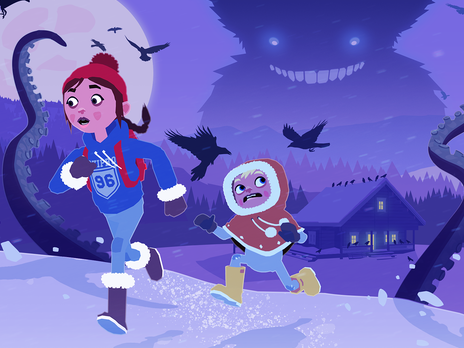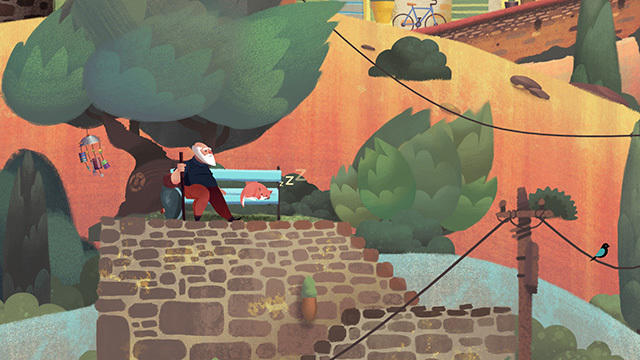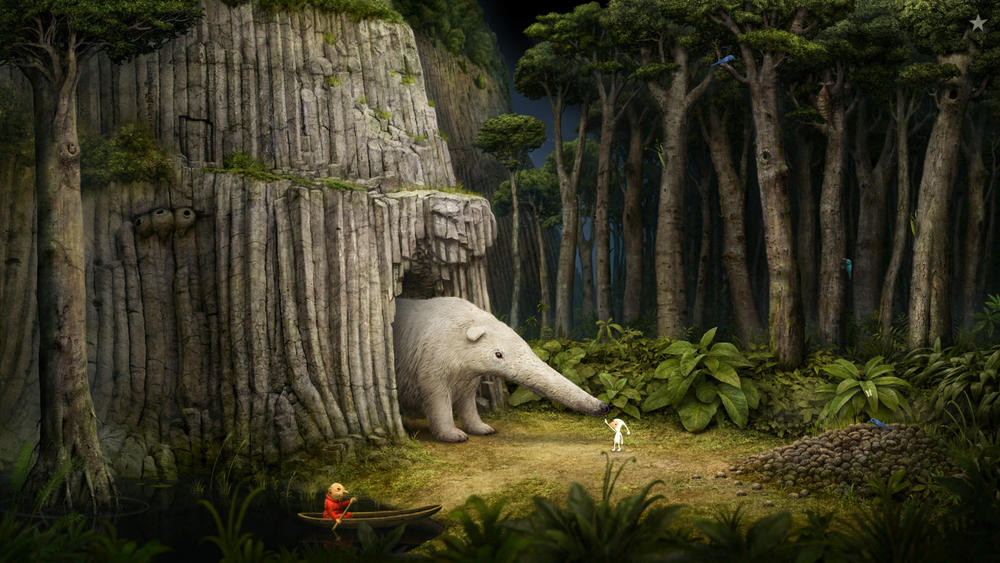Section Branding
Header Content
For The Kid In Your Life, 3 Video Games That Play Like Storybooks
Primary Content
Growing up, I always saw playing video games as a natural extension of my interest in reading. To me, the fantastical worlds I explored in games mirrored those of my favorite children's books like Where the Wild Things Are and The Lorax. Many of the games I played and the stories I read shared a similar sense of whimsy and adventure, and piqued my interest with intriguing art styles.
And that makes sense, given that some video games evoke the feeling of reading a great piece of children's literature. This is especially true for the point-and-click genre (named after the way you play), which can make you feel like you're turning the pages in a book as you progress from scene to scene, moving your character across a static, 2D illustrated background. And just like a children's book, these games encourage you to stop and take in the scene as a whole.
With that in mind, here are three great games to play alongside the kids in your life. While none of them are specifically marketed towards children, they're each still compelling and appropriate for younger players — and they don't require a fancy console or prior experience playing video games. Although some of the puzzles in these games will be too difficult for a kid to figure out alone, they make for a wonderful time that you can share together. Try them sitting side by side, and huddle over the screen together as you tinker through these worlds.
Röki
In an essay for the New York Times Book Review, editor Pamela Paul discussed the contributions of classic children's authors like Maurice Sendak, Shel Silverstein, and Dr. Seuss, saying they "brought a shock of subversion to the genre — defying the notion that children's books shouldn't be scary, silly or sophisticated." While all the games on this list speak to this sentiment to varying degrees, reading Paul's words made me particularly think of Röki.
Polygon Treehouse's phenomenal debut title brings to life a dark, Scandinavian-inspired fairy tale through a contemporary retelling. Röki follows Tove, a young girl, who is trying to save her family after they disappear. As she explores snow-covered Nordic forests, she encounters giant monsters and mystical talking trees with dozens of eyes and magical powers. It's up to her to see if she can contact the spirits she needs to find her family. The characters in the game remind me of creatures from Hayao Miyazaki films like Princess Mononoke or Sendak's Where the Wild Things Are.
Röki switches up the classic point-and-click formula; you'll move using arrow keys rather than the mouse. However, the gameplay mainly stays true to the genre by having you drag and drop items to solve puzzles. I will say, the changes made make the game more playable. I appreciated little features like a button that makes all items glow, because then it becomes pretty obvious what each next step is.
While I think Röki's story will interest kids and adults alike, it does start off on a dark note as Tove loses both her father and her brother. So maybe watch a gameplay video beforehand if you aren't sure it's a good fit for a child.
Old Man's Journey
Old Man's Journey by Broken Rules is a touching story about a father, his mistakes, and how love can stand the test of time and distance. It starts as the protagonist, an old man, receives a letter and sets off on a worldwide journey, and every piece of scenery he passes evokes a memory. A bell you click reminds him of his wedding, a wharf brings back a memory of sailing with his love, and so on. The pastel and gouache-inspired art is vibrant, colorful, and well suited to its various quaint European landscapes.
Point-and-clicks usually use the cursor to move the character through a puzzle. In Old Man's Journey, the landscape itself becomes a puzzle. You click and drag the hills in the background up and down to help the main character proceed from scene to scene. It's also a fitting way to play, given that our main character is an old man, and he moves like one — Mario, he's not.
This game will likely appeal to kids since there is so much to play with in each scene. You can click any animal in the game and it will make some sort of sound. Much of the environment reacts when you simply move the cursor over it — for example, if you move your cursor below waterfalls, the water will flow around it, and the cursor's pointer-finger shape makes you feel like you are poking and prodding at the world.
The Samorost series
Amanita Design — the studio behind Samorost — consistently demonstrates a knack for creating intriguing and whimsical worlds. In the Samorost series, their team designs dreamlike landscapes by combining 2D drawings and detailed close up photos of real-life objects. Their games take something familiar, like dandelions or the roots of a tree, and renders them strange by reworking them into an alien landscape.
In all three titles — Samorost, Samorost 2, and Samorost 3 — you play as a little gnome, and each game has its own story. Samorost tasks you with saving the planet and home of the protagonist. Samorost 2 sends you on a quest to save the gnome's dog after it gets kidnapped by aliens. And Samorost 3 follows the gnome as it investigates the origins of a magical flute that falls from the sky just outside its house.
Many of the scenes in these games look like they were ripped straight out of Alice in Wonderland and are just as strange. Almost immediately after starting the first game, you will encounter a slug with a human face that uses the photo of one of the developers. The scenes and characters you encounter are a true delight.
Growing up, I remember a family friend telling me I would outgrow video games one day. That day never came, but I think that sentiment represents this prevalent idea that video games are childish — the same way that children's books were once seen as immature or simple. These games challenge the idea that playfulness makes video games a lower art form, and instead shows us that today, video games today can be both silly and sophisticated.
Ana Diaz is a freelance games writer and podcast host at MinnMax. She loves Pikachu and is based in Minneapolis, Minn. She tweets at @Pokachee
Copyright 2021 NPR. To see more, visit https://www.npr.org.



